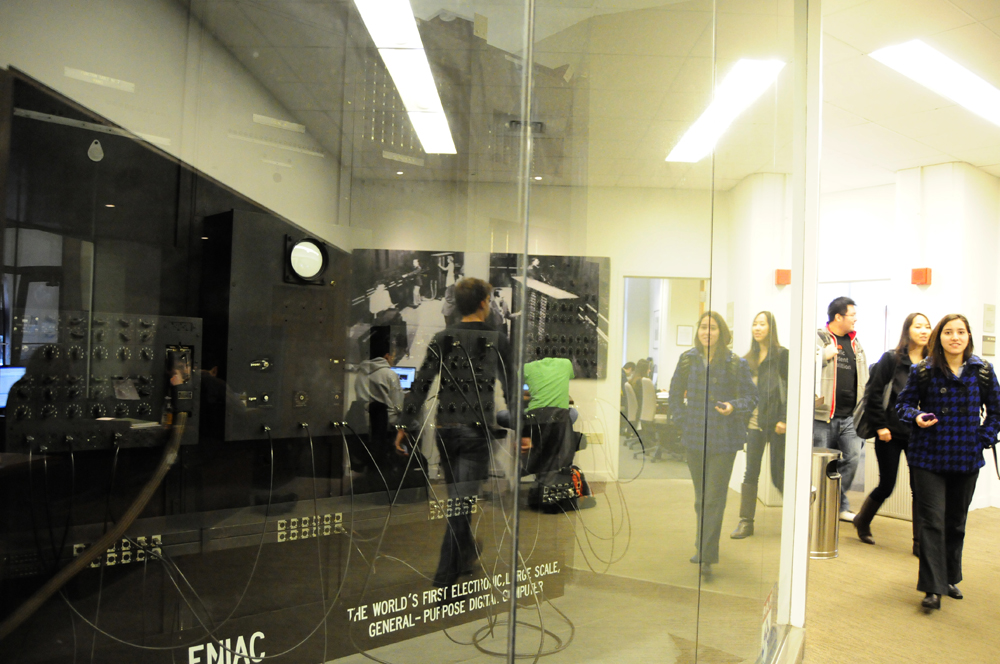
The following is a report done in partnership with Temple University’s Philadelphia Neighborhoods Program, the capstone class for the Temple Journalism Department.
In a small corner of the University of Pennsylvania’s Moore School of Electrical Engineering, marked by a small paper sign, sits Philadelphia’s portion of the remains of the Electronic Numerical Integrator And Computer, or the ENIAC, what many say is the world’s first general use electronic computer.
A small panel of what used to be a massive 30-ton machine rests off in that corner in the Moore Building while engineering students sit a few feet away, browsing Facebook, chatting and eating lunch. The Smithsonian Institution in Washington, D.C., which technically has ownership of all of the ENIAC, has a majority of the remaining pieces of the super computer, but much of it has either been destroyed or otherwise lost.
Last Tuesday, Feb. 15, marked 65 years since John Mauchly and J. Presper Eckert debuted the ENIAC in Philadelphia at Penn’s Moore Building in 1946, an event that Bill Mauchly, a Video Architect at Cisco Systems and son of John Mauchly, said in an interview with Technically Philly marked a massive shift in technology’s history. Learn 10 things you need to know about the ENIAC.
“It was like if today you could walk, and tomorrow you could fly at 5000 miles per hour,” explained Mauchly.

That massive jump in speed and accuracy came from the ENIAC’s ability to process information at electronic speeds, an achievement that earlier mechanically based computers, like the Differential Analyzers built at Penn in the early 1940s, could not attain.
“The longer the Differential Analyzer ran, the more the math went out of synch,” said LeAnn Erickson, a Temple professor and director of “Top Secret Rosies,” a documentary that focuses on the female human computers that programmed ENIAC and contributed, largely without recognition, to the technology advancement that ENIAC represented. Technically Philly spoke to Erickson in the fall.
“With electronics, you have that kind of steadiness that you simply can’t get out of a machine,” she added.
With its invention funded on $500,000 — about $6 million in today’s money — from the U.S. military, the ENIAC was designed to calculate artillery firing tables that would aid troops with shell trajectories in combat.
Erickson says earlier mechanical computers would take 15 minutes to calculate 60-second ballistics trajectories. ENIAC could do the same task in less time than it took for the shell to reach the ground, running at calculating speeds over 1,000 ti-mes faster than its mechanical contenders.
The ENIAC was also programmable, which allowed for its computing power to be applied to a wide range of mathematical tasks. It is widely considered to be the point where the scales tipped, the digital equivalent of the printing press that opened up the information floodgates.
Yet, despite these technological advancements, the ENIAC remains largely unknown and absent from the city of its birth—a fact that Bill Mauchly would like to see changed.
“I would think that people would come here and see the Liberty Bell, have a cheesesteak and then see the ENIAC,” said Mauchly. “And then maybe see the Rocky statue.”
“It’s Philadelphia’s legacy. It should be here,” he added.
Mauchly and his nephew, Jim Reed, a Philadelphia-based artist and grandson of John Mauchly, consider the ENIAC’s lack of “iconization” to be attributable to a number of factors.
Elements of disconnect on the list include Philadelphia’s already overpoweringly rich history, a muddying of the historical waters due to claims that Mauchly and Eckert stole the idea for the machine from the Iowa-based inventors of the Atanasoff-Berry Computer — an early mechanical computer — and a lack of a physical presence of the machine in the city around which a grassroots community could organize.
“ENIAC doesn’t have a parent that cares about it,” explained Mauchly. “It’s a fight that Philadelphia didn’t feel they were up to fighting.”

Reed says, however, it is not the responsibility of the city to promote ENIAC’s legacy.
“There’s a whole bunch of meetings where people hit little gavels and then there’s another plaque,” said Reed. “It has to be more interesting.”
Reed and Mauchly have made efforts towards making ENIAC more interesting in the form of plans for an interactive, nonprofit ENIAC museum at 3747 Ridge Ave., the Marketplace at East Falls. Otherwise known as the birthplace of ENIAC successors BIVAC and UNIVAC.
“We don’t have to pay somebody $5 million to reconstruct it,” said Mauchly. “We can do it and learn a lot in the process.”
Reed says the plan is not to build a regular “bug under glass” museum, but rather an organization in the vein of Philadelphia hackerspaces like Hive 76, Devnuts and the Hacktory, where museum-goers would help construct a full-size, working replica of the ENIAC.
“It would be much less like a traditional museum,” explained Reed. “The advantage would be that you would be bringing in people who have an interest [in ENIAC] and you could be working restoring parts and building replicas.”
The idea, though limited in funding and still in its planning stages, is to build a grassroots community around the ENIAC’s legacy of invention and advancement that will give the machine the physical presence it needs to move up to the pantheon of other more tired Philadelphia favorites like the cheesesteak and Rocky.
“All these other cities and states have rallied around their computers and they’re rebuilding them,” he added. “Half of ENIAC exists, it would not be too hard to rebuild the rest of it.”







